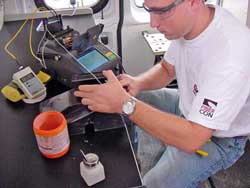Lesson 7: Splices And Terminations

Objectives: From this lesson you should learn:
The difference between terminations with connectors and joints with splices
Should you use connectors or splices?
Requirements for splices and connectors
Splice types
Splicing procedures
Connector styles
Termination types of connectors
Splicing And Termination
In this lesson, a long and very important one, you will learn about fiber splicing and termination. Fiber optic joints or terminations are made two ways: 1) splices which create a permanent joint between the two fibers or 2) connectors that mate two fibers to create a temporary joint and/or connect the fiber to a piece of network gear. Either termination method must have two primary characteristics: good optical performance indicated by low loss minimal reflectance and high reliability. Terminations must also be of the right style to be compatible to the equipment involved and be protected against the environment in which they are installed.
Generally, OSP focuses on splicing, either for joining cables or attaching pigtails for termination. The field termination processes described in the materials are rarely used in OSP applications but should be understood by all techs.
Student Assignment:
Either read the chapter in the textbook, the web page linked on the online reference or watch the videos and take the quiz (Test Your Comprehension)
Book Chapter:
IMSA/FOA Reference Guide to Fiber Optics, Chapter 7
Online FOA Reference: Fiber Optic Terminations and Splicing
FOA YouTube Videos
FOA Lecture 5: Splices and Connectors
FOA Lecture 6: Fiber Optic Splices
FOA Lecture 7: Fiber Optic Connectors
Test Your Knowledge:
Online Quiz
Take the Quiz at the end of Chapter 7 and check your answers
Next: Lesson 8: Fiber Optic Testing
Return to Lesson Plan
|

